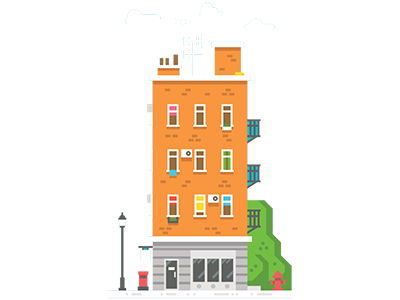What is a Purpose-Built Flat?
- Purpose-built flats are flats which have been constructed from the beginning as flats rather than flats which have been converted from what was originally, for example, a Victorian house or other building.
- However, many Victorian and Georgian properties were purpose-built even then.
- All new-build flats are purpose-built, but not all purpose-built flats are new-builds.
What are the benefits of buying a purpose-built flat?
Purpose-built flats are typically sold as being preferable to period conversion flats because they benefit from these aspects:
- 1
- 2
- 3
- 4
RICS Surveyors | Fixed Fees | Same week availability | Access arranged

Although purpose-built flats are newer than conversion flats, you cannot assume these advantages in most cases without thoroughly examining the property. They are often described as 'soulless' or lacking character compared to older conversion flats. Once again, this depends on the individual example and your own tastes and preferences.
What do purpose-built flats look like?
Purpose-built flats come in all shapes and sizes, from terraced apartment blocks to low-rise & high-rise purpose-built blocks of flats. However, they are generally easy to recognise; you can normally see individual dwellings quite easily, and these look comparatively uniform in shape and layout.
The overall look and character vary. On the upmarket end of the scale, you have complexes like One Hyde Park and The Barbican. On the other, you have many examples of cheaply built social housing from the 1960s and 70s, which were predominantly made of concrete slabs. Many of these are regarded as hideously ugly, and some, such as Belfast's infamous Divis flats, have been pulled down.
What issues do purpose-built flats have?
Most were built comparatively recently; in theory, they have been built to more modern, and therefore higher, building regulations. 
Issues, however, can afflict whole blocks because they have been built uniformly, and so, if there's a fault in some aspect of the overall design, be it masonry or insulation, for example, then there's potential for every flat to suffer from the defect. Minor water leaks from old pipes are a common complaint, and the resulting damage forms the basis of many insurance claims.
If your block has significant defects, with, say, degradation of the concrete used in its construction, it can be harder to get a mortgage and insurance. You should also think about the challenges of resale.
If it was built in the Georgian or Victorian era, there could be issues regarding wiring, and there are increased chances of condensation, mould and damp. However, some older flats from a 'grander' period have better internal spaces than many modern flats, which have been squeezed in to maximise profit in growing cities.
Overheating
Overheating in purpose-built flats has gained media attention. Research has shown that some of these properties get too hot seasonally because of inadequate ventilation, single-aspect flat design, large areas of full-height glazing, and fixed windows.
Frequently, post-2000 new-builds built as care homes or as student accommodation reach summer temperatures as high as 36 degrees Celsius, making the risk of strokes and heart failure much higher, especially among older people.
Do I need a survey on a purpose-built flat?
You need a Level 2 or Level 3 survey when you buy any property ;to find any visible defects or signs of defects and give you the information you need about whether to proceed with the purchase or negotiate with the vendor for a lower price.
For most purpose-built flats, you should get a Level 2 HomeBuyer Report. This is because they are relatively small, unlikely to have been extended or refurbished and more likely to be recently built, so they don't need as thorough an inspection as a level 3.
You would generally only get a full Level 3 Building Survey for this type of property if the flat you want to buy is over 70 years old because the materials are more likely to have degraded.
If you need clarification, please call us at 0333 344 3234, and a member of our team will be delighted to discuss any questions you may have.
Andrew started his career in 2000 working within conveyancing solicitor firms and grew hands-on knowledge of a wide variety of conveyancing challenges and solutions. After helping in excess of 50,000 clients in his career, he uses all this experience within his article writing for SAM, mainstream media and his self published book How to Buy a House Without Killing Anyone.
Caragh is an excellent writer and copy editor of books, news articles and editorials. She has written extensively for SAM for a variety of conveyancing, survey, property law and mortgage-related articles.









